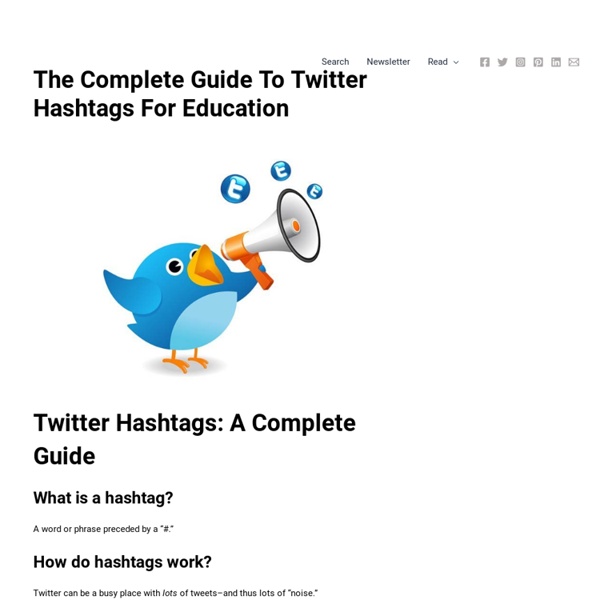The Complete Guide To Twitter Hashtags For Education

https://www.teachthought.com/twitter-hashtags-for-teacher/
Related: To be categorized
• Chromebooks in Education
• Language Arts & Literacy
• missdiamond
Education
ThingLink for teachers and schools Create visual experiences for student-centered learning Start now Trusted Partners Sign up now or contact your closest Microsoft or Google for Education reseller. Award-winning education technology
Google Docs - create and edit documents online, for free.
One account. All of Google. Sign in to continue to Docs Find my account Forgot password?
15 Ways to Make Google Classroom Better for Everyone by Vicki Davis
Today, I’m giving you another peek into my classroom, this time, to share tips for getting the most out of your Google Classroom. In this episode, you’ll hear 15 better practices when using Google Classroom, from habits to technical tools. I’ve also had this show transcribed for your reference.
Pinterest and teachers: How the site is filling a gap in teacher training.
For most of us, Pinterest brings to mind crafts we’ll never make, places we’ll never visit, and wedding dresses we’ll never buy. But when teachers log on to the social scrapbooking site, they search for things like pasta-noodle skeletons, rock-candy recipes, and numbered cootie catchers—not as part of a crazy home-decorating scheme, but to actually use in their classrooms. At a time when social media has broken down geographic barriers across countless professions, teachers have turned to places like Pinterest in droves, and not because they’re particularly prone to distraction. For thousands of teachers, Pinterest has become an important venue for professional development—a place to find creative lesson plans, classroom decorations, and teaching tips. Suzy Brooks, a fourth-grade teacher in Falmouth, Massachusetts, checks Pinterest multiple times a day, scouring the site for discoveries that often make their way into her classroom, sometimes within hours.
The Busy Person's Guide to Content Curation: A 3-Step Process
Museums curate works of art. We digital marketers curate blog posts. Though our link shares may not be artistic contributions, the idea of curation is at least the same at museums and online: We’re all seeking only the best material to pass along to our patrons, customers, fans, or followers.
50 Ways to Use Twitter in the Classroom
Many critics of Twitter believe that the 140-character microblog offered by the ubiquitous social network can do little for the education industry. They are wrong. K-12 teachers have taken advantage of Twitter’s format to keep their classes engaged and up-to-date on the latest technologies. The following projects provide you and your students with 50 ways to Twitter in the classroom to create important and lasting lessons.
Educational Hash Tags
#edude#eduFollowChallenge#edugreen #eduhashtag #eduit#edumindset#eduON (Ontario)#euduoz #edupd#edupreneur#edupunk #edutech #EduThingsILike#eduvc#eduvoxers #elemchat #elementary#elemsci #ell #ellchat#elrnchat #elt#eltchat#eltpics#emchat #emotionalliteracy#edpolitics #engagechat#engchat #engedu #EngineeringEducation#english #english-teacher#engsschat #enrichingkids#enviroed#e-safety#ESCchat#esdgc#esea#esl #esol#esp#ETAS#etcchat#ETcoaches#etmchat#ettipad #e20#expandedlearning
Using Sound Texts in Antiracist Teaching in Middle and High School
Educators are facing the intimidating reality of remote classrooms this fall; many are also looking for new ways to promote antiracism because familiar methods may have seemed more authentic, manageable, or accessible in an in-person classroom. We would like to offer some ideas for how humanities teachers in particular can use texts that use sound—podcasts, speeches, interviews, music, and the like—to integrate antiracist content into online classrooms. Texts written with sound offer a number of high-value benefits to a remote classroom, including being organically accessible to English language learners and students with learning challenges like dyslexia, as well as being simple and affordable. Working with sound also allows educators to teach necessary skills in new and exciting ways that invite both intellectual play and literacy with digital tools.
Related:
Educational HashTags
•
IKT
•
technology for education



